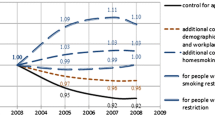Abstract
This study uses a series of nationally representative samples from China. We studied more than 4,000 households to explore factors associated with both the prevalence and the frequency of cigarette smoking over 13 years between 1991 and 2004. By introducing variables at both the individual and the community level, we found that some key variables are consistent predictors of smoking measures over time, thus they should be the targets of future intervention/prevention programs.
Similar content being viewed by others
References
CATC(Chinese Association on Tobacco Control). http://www.cash-prc.com.
Best Foundation. Secondhand Smoke Affects 600 Million in China Retrieved April 15, 2006, from http://www.jointogether.org/news/headlines/inthenews/2006/secondhand-smoke-affects-600.html.
MacKay J . China's Tobacco Wars. Retrieved 22 April 2006, from http://multinationalmonitor.org/hyper/issues/1992/01/mm0192_06.html.
Pan Z . Socioeconomic predictors of smoking and smoking frequency in urban China: evidence of smoking as a social function. Health Promotion Int. 1992;19 (3):309–315.
Gong YL, Koplan JP, Feng W, Chen CH, Zheng P, Harris JR . Cigarette smoking in China: prevalence, characteristics, and attitudes in Minhang district. J Am Med Assoc. 1995;274:1232–1235.
Hesketh T, Ding QJ, Tomkins A . Smoking among youths in China. Am J Public Health. 2001;91 (10):1653–1655.
Li X, Fang X, Stanton B . Cigarette smoking among schoolboys in Beijing, China. 1999. J Adolescence. 1999;22 (5):621–625.
Zhang L, Wang W, Zhao Q, Vartiainen E . Psychosocial predictors of smoking among secondary school students in Henan, China. Health Educ Res. 2000;15 (4):415–423.
Sun W, Shun J . Smoking behavior among different socioeconomic groups in the work place in the People's Republic of China. Health Promotion Int. 1995;10 (4):261–266.
Xiang H, Wang Z, Stallones L, Yu S, Gimbel HW, Yang P . Cigarette smoking among medical college students in Wuhan, People's Republic of China. Prev Med. 1999;29 (3):210–215.
Levy D . The Role of Public Policies in Reducing Smoking and Deaths Caused by Smoking in China: Results from the China Tobacco Policy Simulation Model. New York, NY: World Health Organization; 2006.
Yang Y, Jiang Y, Yang X, Deng Y, Li J, Guo Z, et al. Analysis on main factors for successful quitting: study on the one-year follow-up for Chinese “Quit and Win” in 2002. Wei Sheng Yan Jiu. 2004;33 (4):478–480.
Yang G, Fan L, Tan J, Qi G, Zhang Y, Samet JM, et al. Smoking in China: findings of the 1996 National Prevalence Survey. JAMA. 1999;282 (13):1247–1253.
Bian Y . Guanxi and the allocation of urban jobs in China. The China Quarterly. 1994;140:971–999.
Zheng H, Sussman S, Chen X, Wang Y, Xia J, Gong J, et al. Project EX – a teen smoking cessation initial study in Wuhan, China. Addict Behav. 2004;29 (9):1725–1733.
Yang Y, Jiang Y, Yang X, Deng Y, Li J, Guo Z, et al. Analysis on main factors for successful quitting: study on the one-year follow-up for Chinese “Quit and Win” in 2002 (Chinese). 2004. Wei Sheng Yan Jiu. 2004;33 (4):478–480.
Loke AY, Lam TH . A randomized controlled trial of the simple advice given by obstetricians in Guangzhou, China, to non-smoking pregnant women to help their husbands quit smoking. Patient Educ Counseling. 2005;59 (1):31–37.
Chan SS, Lam TH, Salili F, Leung GM, Wong DC, Botelho RJ, et al. A randomized controlled trial of an individualized motivational intervention on smoking cessation for parents of sick children: a pilot study. 2005. Appl Nursing Res. 2005;18 (3):178–181.
Abdullah AS, Mak YW, Loke AY, Lam TH . Smoking cessation intervention in parents of young children: a randomised controlled trial. Addiction. 2005;100 (11):1731–1740.
Bryk AS, Raudenbush SW . Hierarchical Linear Models: Applications and Data Analysis Methods. Newbury Park: Sage; 1992.
Cohen J . Statistical Power Analysis for the Behavioral Sciences. Hillsdale, NJ: Lawrence Erlbaum Associates; 1988.
Wang HK . The impact of tobacco expenditure on household consumption patterns in rural China. Soc Sci Med. 2006;62 (6):1414–1426.
Fielding R, Chee YY, Choi KM, Chu TK, Kato K, Lam SK, et al. Declines in tobacco brand recognition and ever-smoking rates among young children following restrictions on tobacco advertisements in Hong Kong. J Public Health. 2004;26 (1):24–30.
Author information
Authors and Affiliations
Corresponding author
Additional information
A study over 13 years of cigarette smoking by individuals in 4000 households in China consistently points to predictors crucial for tobacco control programs.
Rights and permissions
About this article
Cite this article
Pan, Z., Hu, D. Multilevel Analysis of Individual and Community Predictors of Smoking Prevalence and Frequency in China: 1991–2004 . J Public Health Pol 29, 72–85 (2008). https://doi.org/10.1057/palgrave.jphp.3200163
Published:
Issue Date:
DOI: https://doi.org/10.1057/palgrave.jphp.3200163




